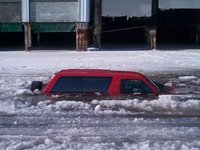Numb and Number

When I was growing up in small town Minnesota, the winters were very long. One of the rites of spring was to look forward to a contest that signified the coming of summer and the thaw, the “Ice Buster” contest.
The Moose Lake Chamber of Commerce would hold a raffle each winter. A contest where people had the opportunity to purchase a chance to correctly guess the date and time when the ice would get thin. Thin enough for the car that they would drag out onto the ice each winter to fall through and sink to the bottom. A good opportunity this raffle, as there were only 1438 people in the whole town; compared to the lottery these are stellar odds.
I contacted my favorite newspaper, the Moose Lake Star Gazette, to see if I could obtain some archival pictures or articles that documented this important annual event. The editor and publisher of the Star Gazette, Jerry DeRungs, reported “I also remember the ‘Ice Buster’, but DNR regulations prohibit that activity now days”.
You can’t intentionally drop cars in lakes anymore?! There’s definitely too much government intervention in our lives these days.
The DNR, the Department of Natural Resources, is a very important government department. Especially in Minnesota where there are an abundance of natural resources. Natural resources like ice.
The DNR website helpfully provides this useful metaphor for assessing ice safety:
“Ice is not really that solid, like blacktop or concrete on the ground. It might be better to think about the surface of a frozen lake as thinly rolled dough stretched over a hoop. Place a large marble on the dough and, like ice, it sags in the middle but it doesn't break. If you put enough marbles next to each other on the dough, eventually it's going to give way”.
Nice.
But the DNR website also offers relief for those of us who must drive on the ice:
- Check the ice often, at least every 150 feet or more often if the ice thicknesses are found to be quite variable.
- Leave at least 60 feet between vehicles parked on ice and drill a hole in the ice near your car. If water overflows the edges of the hole, move the vehicle immediately; it is starting to sink.
- If you see concentric cracks circling around the perimeter of the vehicle, it is time to move it.
- Don't drive on the ice at night if at all possible; a newly opened hole might not be visible in low light conditions.
- Leave windows down, seatbelts unbuckled and doors ajar for a quick exit if the vehicle breaks through.
- Drive across wet cracks in the ice as close to perpendicular as possible and assume the ice strength is one-half that of new solid clear ice.
- Bail out as soon as the car starts to break through. Don't wait for it to settle to the bottom. Cars often turn upside down as they sink, which combined with freezing water, make breath holding more difficult and limit visibility. Mud pushing against the doors can make escape nearly impossible.
- Don't drive faster than 15 miles per hour. Faster speeds can cause waves in the ice, much like a boat's wake in the summer, which can cause already weak ice to shatter.
DNR recommendation: drive around with your seatbelt unbuckled, window open (ignoring the sub-zero temperatures outside), while keeping the door ajar.
I feel much safer now.

1 Comments:
Good ideas never die.
https://jalopnik.com/people-in-michigan-are-betting-on-when-a-decrepit-satur-1832656720
By Anonymous, at 7:03 PM
Anonymous, at 7:03 PM
Post a Comment
<< Home